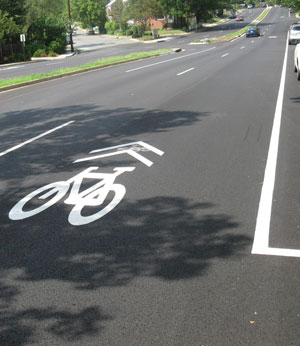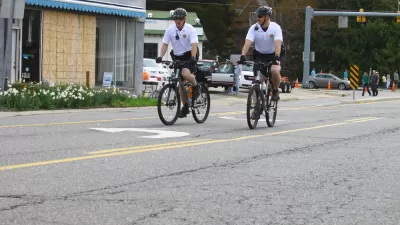Sharrows and 3-foot passing laws are meant to make biking safer in streets in the absence of bike lanes. Bike activists in Iowa want to take safety a step further by requiring motorists to move to another lane, just as they would if passing a car.
The bill, known as "Change Lanes to Pass Bicyclists" or Senate File (SF) 2224 "would require motor vehicles to use the opposite side of the road or an adjacent travel lane to pass people on bicycles," states the legislative page of the Iowa Bicycle Coalition "It also recognizes that paved shoulders and bike lanes are adjacent travel lanes, and prohibits motorists from steering unreasonable close to people riding bicycles in those lanes."
Current Iowa law "prohibits motorists from driving 'unreasonably close' to cyclists," writes Molly Montag of the Globe Gazette. Last year 26 states plus the District of Columbia passed laws requiring motorists to pass no less than three feet from a cyclist, according to the National Conference of State Legislatures.

Credit: NCSL, Safely Passing Bicyclists Chart, 12/17/2015
"Approximately half of Iowa cyclists killed in the past 10 years have been hit during passing incidents, said Iowa Bicycle Coalition Executive Director Mark Wyatt," writes Montag.
“We want the law very crystal clear that you pass a bicycle like you would pass any other vehicle on the roadway,” Wyatt said.
SF 2224 passed the Transportation Committee, 12-0 and the Senate, 38-12, and now advances to the House, according to Iowa Bicycle Coalition webpage. The Iowa Chapter of the Sierra Club is supporting the bill [PDF].
Another safety strategy is to add sharrows to the asphalt along with roadway signs indicating to both cyclists and motorists that the both are to share the lane. While better than no such signs, many question their effectiveness to improve safety and increase cycling.
Credit: Bike Arlington

Readers can listen to a 49-minute talk with Mark Wyatt on bike culture in the Hawkeye State on Iowa Public Radio. The "Talk of Iowa" show was aired last September followed the tragic death of a cyclist by a drunk driver.
Hat tip to AASHTO Daily Transportation Update.
FULL STORY: Proposed bicycle safety law much needed, North Iowa cyclists say

Maui's Vacation Rental Debate Turns Ugly
Verbal attacks, misinformation campaigns and fistfights plague a high-stakes debate to convert thousands of vacation rentals into long-term housing.

Planetizen Federal Action Tracker
A weekly monitor of how Trump’s orders and actions are impacting planners and planning in America.

In Urban Planning, AI Prompting Could be the New Design Thinking
Creativity has long been key to great urban design. What if we see AI as our new creative partner?

King County Supportive Housing Program Offers Hope for Unhoused Residents
The county is taking a ‘Housing First’ approach that prioritizes getting people into housing, then offering wraparound supportive services.

Researchers Use AI to Get Clearer Picture of US Housing
Analysts are using artificial intelligence to supercharge their research by allowing them to comb through data faster. Though these AI tools can be error prone, they save time and housing researchers are optimistic about the future.

Making Shared Micromobility More Inclusive
Cities and shared mobility system operators can do more to include people with disabilities in planning and operations, per a new report.
Urban Design for Planners 1: Software Tools
This six-course series explores essential urban design concepts using open source software and equips planners with the tools they need to participate fully in the urban design process.
Planning for Universal Design
Learn the tools for implementing Universal Design in planning regulations.
planning NEXT
Appalachian Highlands Housing Partners
Mpact (founded as Rail~Volution)
City of Camden Redevelopment Agency
City of Astoria
City of Portland
City of Laramie





























